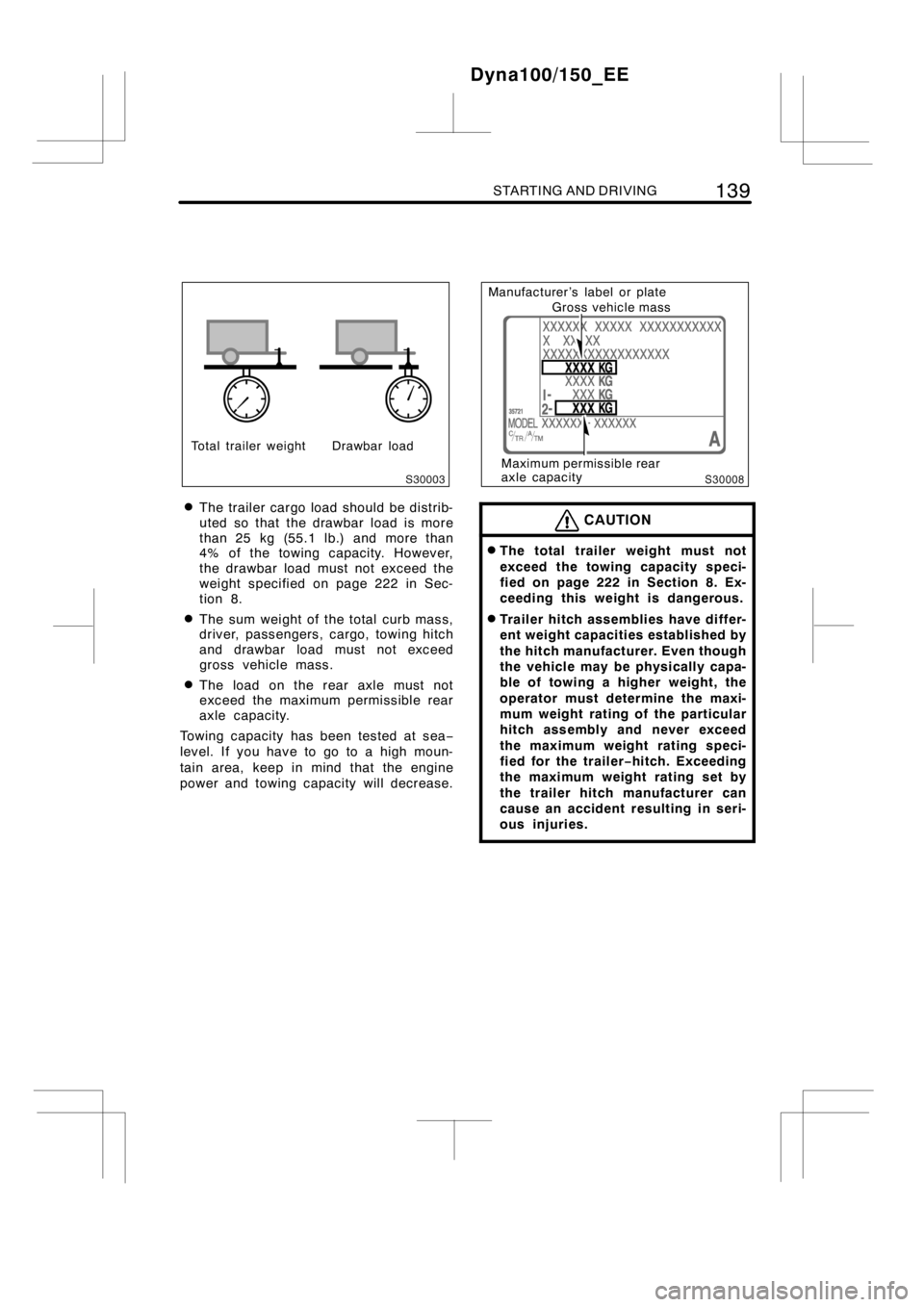Page 144 of 240

138STARTING AND DRIVING
Keep the door locks from freezing.
Squirt lock de−icer or glycerine into the
locks to keep them from freezing. To open
a frozen lock, try heating the key before
inserting it.
Use a washer fluid containing an anti-
freeze solution.
This product is available at any authorized
Toyota dealer or repairer and most auto
parts stores or another qualified professio-
nal. Follow the manufacturer ’s directions
for how much to mix with water.
NOTICE
Do not use engine antifreeze or any
other substitute because it may dam-
age your vehicle’s paint.
Do not use your parking brake when
there is a possibility it could freeze.
When parking, put the transmission into
first or reverse and block the front
wheels. Do not use the parking brake, or
snow or water accumulated in and around
the parking brake mechanism may freeze,
making it hard to release.
Keep ice and snow from accumulating
under the fenders.
Ice and snow built up under your fenders
can make steering difficult. During bad
winter driving, stop and check under the
fenders occasionally.
Depending on where you are driving,
we recommend you carry some emer-
gency equipment.
Some of the things you might put in the
vehicle are tire chains, window scraper,
bag of sand or salt, flares, small shovel,
jumper cables, etc.Your vehicle is designed primarily as a
passenger−and−load−carrying vehicle. Tow-
ing a trailer will have an adverse effect on
handling, performance,braking,durability
and driving economy (fuel consumption,
etc.). Your safety and satisfaction depend
on the proper use of correct equipment
and cautious driving habits. For your safe-
ty and the safety of others, you must not
overload your vehicle or trailer. Ask your
local authorized Toyota dealer or repairer,
or another duly qualified and equipped
professional, for further details before tow-
ing, as there are additional legal require-
ments in some countries.
WEIGHT LIMITS
Before towing, confirm the towing capacity,
gross vehicle mass (GVM), maximum per-
missible axle capacity (MPAC) and draw-
bar load. They are listed on page 222 in
Section 8.
When towing a trailer, observe the follow-
ing:
DThe total trailer weight (trailer weight
plus its cargo load) is within the towing
capacity.
DWhen the total trailer weight is greater
than the vehicle weight, we recommend
the use of a friction stabilizer (sway
control device).
DWhen the total trailer weight is over
2000 kg (4409 lb.), a friction stabilizer
(sway control device) is required.
Dyna100/150_EE
Trailer towing
Page 145 of 240

STARTING AND DRIVING139
Total trailer weight Drawbar load
DThe trailer cargo load should be distrib-
uted so that the drawbar load is more
than 25 kg (55.1 lb.) and more than
4% of the towing capacity. However,
the drawbar load must not exceed the
weight specified on page 222 in Sec-
tion 8.
DThe sum weight of the total curb mass,
driver, passengers, cargo, towing hitch
and drawbar load must not exceed
gross vehicle mass.
DThe load on the rear axle must not
exceed the maximum permissible rear
axle capacity.
Towing capacity has been tested at sea−
level. If you have to go to a high moun-
tain area, keep in mind that the engine
power and towing capacity will decrease.
Manufacturer’s label or plate
Gross vehicle mass
Maximum permissible rear
axle capacity
CAUTION
DThe total trailer weight must not
exceed the towing capacity speci-
fied on page 222 in Section 8. Ex-
ceeding this weight is dangerous.
DTrailer hitch assemblies have differ-
ent weight capacities established by
the hitch manufacturer. Even though
the vehicle may be physically capa-
ble of towing a higher weight, the
operator must determine the maxi-
mum weight rating of the particular
hitch assembly and never exceed
the maximum weight rating speci-
fied for the trailer−hitch. Exceeding
the maximum weight rating set by
the trailer hitch manufacturer can
cause an accident resulting in seri-
ous injuries.
Dyna100/150_EE
Page 146 of 240
140STARTING AND DRIVING
DThe sum weight of the total curb
mass, driver, passengers, cargo,
towing hitch, and drawbar load
must not exceed the gross vehicle
mass. Exceeding this weight is dan-
gerous.
DThe load on the rear axle must not
exceed the maximum permissible
rear axle capacity. Exceeding this
weight is dangerous.
TOWING HITCH BRACKETS
Toyota recommends using a Toyota genu-
ine hitch and bracket. Another hitch and
bracket of matching quality can also be
used.
Installation positions for towing hitch
brackets and towing hitch ball overhang:
Dyna100/150_EE
Page 186 of 240

180CORROSION PREVENTION AND APPEARANCE CARE
Exterior lights: Wash carefully. Do not use
organic substances or scrub them with a
hard brush. This may damage the sur-
faces of the lights.
Road tar: Remove with turpentine or
cleaners that are marked safe for painted
surfaces.
3. Rinse thoroughly—dried soap can
cause streaking. In hot weather you
may need to rinse each section right
after you wash it.
4. To prevent water spots, dry the vehicle
using a clean soft cotton towel. Do not
rub or press hard—you might scratch
the paint.
NOTICE
zDo not use organic substances
(gasoline, kerosene, benzine or
strong solvents), which may be tox-
ic or cause damage.
zDo not scrub any part of the ve-
hicle with a hard brush, which may
cause damage.
Waxing your Toyota
Polishing and waxing is recommended
to maintain the original beauty of your
Toyota’s finish.
Apply wax once a month or if the vehicle
surface does not repel water well.
1. Always wash and dry the vehicle be-
fore you begin waxing, even if you are
using a combined cleaner and wax.
2. Use a good quality polish and wax. If
the finish has become extremely weath-
ered, use a car−cleaning polish, fol-
lowed by a separate wax. Carefully fol-
low the manufacturer ’s instructions and
precautions. Be sure to polish and wax
the chrome trim as well as the paint.Exterior lights: Do not apply wax on the
surfaces of the lights. Wax may cause
damage to the lenses. If you accidentally
put wax on the light surfaces, wipe or
wash it off.
3. Wax the vehicle again when water
does not bead but remains on the sur-
face in large patches.
Touch−up paint
Touch−up paint may be used to cover
small chips or scratches.
Apply the paint soon after the damage
occurs or corrosion may set in. To do a
good job, use a small artist’s brush and
stir the paint well. Make sure the area is
clean and dry. To apply the touch−up paint
so it is hardly noticeable, the trick is to
apply it only to the bare spots. Apply only
the smallest amount possible and do not
paint the surface around the scratch or
chip.
Dyna100/150_EE
Page 228 of 240
222SPECIFICATIONS
kg (lb.)
Model
Gross Vehicle
Mass(GVM)
Maximum Permissible Axle
Capacity (MPAC)
ModelMass (GVM)FrontRear
Dyna100�Single cab�3000 (6614)1800(3968)1800(3968)Dyna100�
Double cab�3210 (7077)1800(3968)1800(3968)
Dyna 150�3500 (7716)1800 (3968)2550 (5622)
kg (lb.)
ModelDrawbarloadTowing capacityModelDrawbarloadWith brakeWithout brake
Dyna 100�110 (243)2000 (4409)750 (1653)
Dyna 150�115 (254)2200 (4850)750 (1653)
�: See “Model code” on page vi in the beginning of this manual if you are not sure of
your vehicle model.
Dyna100/150_EE
Weights